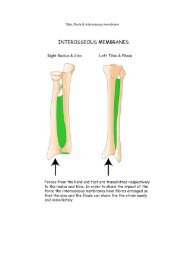GSM 11.11 version 6.2.0 - TTFN Smart card pages
GSM 11.11 version 6.2.0 - TTFN Smart card pages
GSM 11.11 version 6.2.0 - TTFN Smart card pages
- No tags were found...
You also want an ePaper? Increase the reach of your titles
YUMPU automatically turns print PDFs into web optimized ePapers that Google loves.
(<strong>GSM</strong> <strong>11.11</strong> <strong>version</strong> <strong>6.2.0</strong> Release 1997)21TS 100 977 V<strong>6.2.0</strong> (1999-05)PTS Request and PTS Response consist of the four (4) characters PTSS, PTSO, PTS1 and PCK of which PTSS is sentfirst.After this procedure the protocol T=0 and the parameters F=512, D=8 and N=0 will be used.5.8.3 Speed enhancementIf speed enhancement is implemented, the ME and the SIM shall at least support F=512 and D=8 in addition to F=372and D=1. However, other values may also be supported. If the ME requests PTS using values other than those abovethen the PTS procedure shall be initiated accordingly.The SIM shall support the default value (F=372 and D=1). If the speed enhancement is supported by the SIM it ismandatory that F=512 and D=8 is supported. However, the value in TA1 may even indicate a faster speed (F=512 andD=16). The SIM may also support other values between the default value (F=372 and D=1) and the values indicated inTA1. The SIM shall offer the negotiable mode, to ensure backwards compatibility with existing MEs. In the negotiablemode the SIM will use default values even if other parameters are offered in the ATR if the PTS procedure is notinitiated.The ME shall support the default value (F=372 and D=1). If the speed enhancement is supported in the ME it ismandatory to support F=512 and D=8. The ME may additionally support other values.If the SIM does not answer the PTS request within the initial waiting time the ME shall reset the SIM. After two failedPTS attempts using F=512 and D=8 or values indicated in TA1, (no PTS response from the SIM) the ME shall initiatePTS procedure using default values. If this also fails (no PTS response from the SIM) the ME may proceed using defaultvalues without requesting PTS.If the SIM does not support the values requested by the ME, the SIM shall respond to the PTS request indicating the useof default values.5.9 Bit/character duration and sampling timeThe bit/character duration and sampling time specified in ISO/IEC 7816-3 [26], subclauses 6.1.1 and 6.1.2, are valid forall communications.5.10 Error handlingFollowing receipt of an ATR, which is not in accordance with the present document, e.g. because of forbidden ATRcharacters or too few bytes being transmitted, the ME shall perform a Reset. The ME shall not reject the SIM until atleast three consecutive wrong ATRs are received.During the transmission of the ATR and the protocol type selection, the error detection and character repetitionprocedure specified in ISO/IEC 7816-3 [26], subclause 6.1.3, is optional for the ME. For the subsequent transmission onthe basis of T=0 this procedure is mandatory for the ME.For the SIM the error detection and character repetition procedure is mandatory for all communications.6 Logical ModelThis clause describes the logical structure for a SIM, the code associated with it, and the structure of files used.6.1 General descriptionFigure 3 shows the general structural relationships which may exist between files. The files are organized in ahierarchical structure and are of one of three types as defined below. These files may be either administrative orapplication specific. The operating system handles the access to the data stored in different files.ETSI








